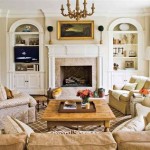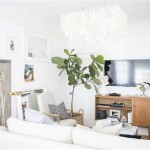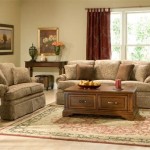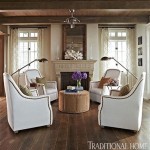Bedroom Living Room Combo Design Ideas
The convergence of living spaces into multifaceted areas is an increasingly common approach to interior design, particularly in urban environments where space is often at a premium. The bedroom living room combo represents a deliberate effort to maximize functionality and aesthetic appeal within a single room. This requires careful planning and execution to ensure that the space is both comfortable and practical, serving the needs of both relaxation and entertainment. This article will explore various design ideas for creating a successful bedroom living room combo, emphasizing key considerations and strategies for optimizing the space.
One of the primary challenges in designing a bedroom living room combo is creating a sense of separation between the two distinct functions. The bedroom area should evoke a feeling of tranquility and rest, while the living area should be inviting and conducive to social interaction or individual leisure activities. Achieving this separation requires a strategic approach to layout, furniture selection, and the use of visual cues.
Strategic Zoning Techniques
Zoning involves the deliberate allocation of space within a room to define specific areas for different activities. In a bedroom living room combo, zoning becomes essential for creating a functional and visually appealing environment. Several techniques can be employed to achieve effective zoning.
Furniture Arrangement: The arrangement of furniture plays a critical role in defining zones. A sofa, for instance, can act as a physical barrier between the living area and the bedroom area. Placing the sofa with its back facing the bed can create a visual division, effectively delineating the two spaces. Similarly, a bookshelf or a console table can serve as a partition, providing both storage and visual separation. The strategic placement of a rug can also define the living area, creating a distinct space within the larger room.
Visual Dividers: Visual dividers are design elements that create a sense of separation without completely blocking the view or light. Curtains, screens, and shelving units are common examples of visual dividers. Curtains offer flexibility, allowing the space to be opened up or closed off as needed. Screens provide a more permanent division while still maintaining a degree of visual permeability. Shelving units, particularly those with an open back, offer both storage and visual separation, allowing light to pass through while defining the boundaries of each zone.
Color and Texture: The use of color and texture can also contribute to effective zoning. Different colors can be used to distinguish between the living area and the bedroom area. For instance, using warmer, more vibrant colors in the living area and cooler, more calming colors in the bedroom area can help to create a psychological separation. Similarly, varying textures can be used to differentiate the two zones. For example, a plush rug in the living area and a smoother, more minimalist rug in the bedroom area can create a subtle but effective distinction.
Lighting: Lighting design is fundamental to creating distinct zones. The living area might benefit from brighter, more focused lighting, suitable for reading or socializing. In contrast, the bedroom area should prioritize softer, more ambient lighting to promote relaxation and sleep. The use of dimmer switches allows for adjusting the lighting levels according to the specific needs of each zone. Task lighting, such as a desk lamp or reading light, can further enhance the functionality of each area.
The successful implementation of these zoning techniques will result in a bedroom living room combo that feels both cohesive and functional, with each area clearly defined and serving its intended purpose.
Optimizing Space Through Multifunctional Furniture
In a combined bedroom living room, space optimization is paramount. Multifunctional furniture is a critical element in achieving this optimization, allowing single pieces of furniture to serve multiple purposes. This approach not only saves space but also enhances the overall functionality of the room.
Sofa Beds: The sofa bed is a classic example of multifunctional furniture, providing seating during the day and a sleeping surface at night. Sofa beds have evolved significantly in recent years, with many modern designs offering both comfort and style. When selecting a sofa bed, it is important to consider the quality of the mattress and the ease of conversion between sofa and bed. A comfortable and easy-to-use sofa bed can significantly enhance the functionality of the bedroom living room combo.
Storage Beds: Storage beds provide valuable storage space underneath the mattress, which can be used to store bedding, clothing, or other items. This is particularly useful in small spaces where storage is limited. Storage beds come in various designs, including those with drawers, lift-up mechanisms, and built-in shelves. Choosing a storage bed that complements the overall design of the room can help to maximize both storage and aesthetic appeal.
Ottomans with Storage: Ottomans with built-in storage provide a flexible seating option and additional storage space. They can be used as footrests, coffee tables, or extra seating when needed. The storage compartment can be used to store blankets, pillows, or other items. Ottomans are available in a wide range of styles and materials, making it easy to find one that complements the existing decor.
Foldable Desks and Tables: Foldable desks and tables provide a temporary workspace or dining surface that can be easily stowed away when not in use. This is particularly useful in small spaces where a permanent desk or table would take up too much room. Foldable desks and tables are available in various designs, including wall-mounted options and freestanding models. They can be used for working, studying, or dining, and then easily folded away to free up space.
Coffee Tables with Lift-Top Mechanisms: Coffee tables with lift-top mechanisms provide a convenient surface for working, eating, or playing games while sitting on the sofa. The lift-top mechanism allows the table to be raised to a comfortable height, making it easier to work or eat without having to bend over. When not in use, the table can be lowered to its original position. These coffee tables often include storage underneath the lift-top, providing additional space for storing remotes, magazines, or other items.
By incorporating multifunctional furniture into the design, it is possible to create a bedroom living room combo that is both functional and stylish, maximizing the use of space and providing versatile solutions for everyday needs.
Creating a Cohesive Design Aesthetic
While zoning and multifunctional furniture are essential for functionality, creating a cohesive design aesthetic is equally important for the overall appeal of the bedroom living room combo. A cohesive design ensures that the space feels harmonious and inviting, rather than disjointed and cluttered.
Consistent Color Palette: A consistent color palette is fundamental to creating a cohesive design. Choosing a limited number of colors and using them throughout the room can help to unify the space. The color palette should be chosen based on personal preferences and the desired mood of the room. Neutral colors, such as white, gray, and beige, can create a calming and sophisticated atmosphere, while bolder colors can add energy and personality. Regardless of the chosen colors, it is important to use them consistently throughout the room to create a sense of harmony.
Unified Style: The style of furniture and decor should be consistent throughout the room. Whether the chosen style is modern, traditional, bohemian, or eclectic, it is important to maintain a consistent aesthetic. Mixing styles can be done effectively, but it requires careful consideration to ensure that the different elements complement each other. Choosing furniture and decor that share common characteristics, such as similar shapes, materials, or colors, can help to create a unified style.
Consistent Textures and Patterns: The use of textures and patterns can also contribute to a cohesive design. Similar to colors, textures and patterns should be used consistently throughout the room. Using a variety of textures, such as smooth, rough, and soft, can add depth and interest to the space. Patterns can also be used to add visual appeal, but it is important to use them sparingly and to ensure that they complement the overall design. Using a consistent pattern on pillows, rugs, or curtains can help to tie the room together.
Unified Lighting Scheme: A unified lighting scheme is essential for creating a cohesive design. The lighting should be consistent in terms of color temperature and style. Using a combination of ambient, task, and accent lighting can create a well-lit and inviting space. The lighting fixtures should complement the overall style of the room and should be chosen to enhance the functionality of the different zones. Using dimmer switches can allow for adjusting the lighting levels to create different moods.
Consistent Accessories: Accessories, such as artwork, plants, and decorative objects, can add personality and character to the space. Choosing accessories that complement the overall design and using them consistently throughout the room can help to create a cohesive aesthetic. The accessories should be chosen to reflect personal preferences and to enhance the overall mood of the room. Using a variety of sizes and shapes can add visual interest, but it is important to avoid clutter and to maintain a sense of balance.
By paying attention to these details, it is possible to create a bedroom living room combo that is not only functional but also visually appealing, creating a space that is both comfortable and stylish.
Careful consideration of these design elements, including zoning strategies, the use of multifunctional furniture, and the creation of a cohesive aesthetic, can transform a challenging space into a harmonious and functional living environment. Adapting these principles to specific needs and preferences will ultimately contribute to a successful bedroom living room combo design.

Clever Ways To Design A Living Room And Bedroom Combo

14 Living Room Bedroom Combo Ideas To Optimize Floor Space Coco Lapine Designcoco Design

17 Amazing Living Room Bedroom Ideas You Need To See The Decor Forum

10 Small Living Room And Bedroom Combo Makeover

Living Room Bedroom Combo Small Spaces Apartments

Great Living Room Bedroom Combo Ideas Layout Tips Styling The Nordroom

It Can Work When Your Living Room Is Bedroom

Great Living Room Bedroom Combo Ideas Layout Tips Styling The Nordroom

10 Living Room Bedroom Combo Ideas 2025 The Dual Deals

14 Living Room Bedroom Combo Ideas To Optimize Floor Space Coco Lapine Designcoco Design








